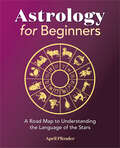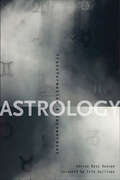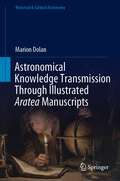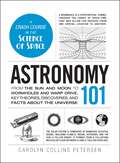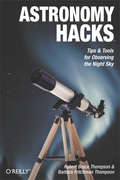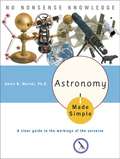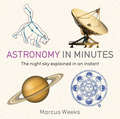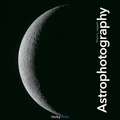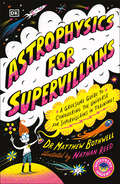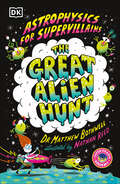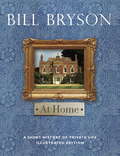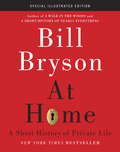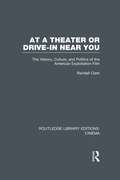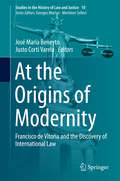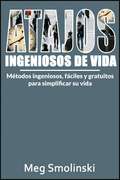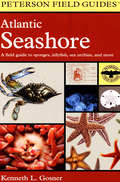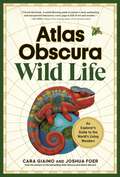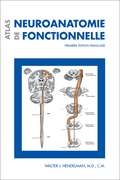- Table View
- List View
Astrology for Beginners: A Road Map to Understanding the Language of the Stars
by April PfenderSee what the stars are saying about you!Do you know your sun sign? Moon sign? Rising sign? Astrology can open new doors to self-discovery and spark life-changing growth—and this zodiac book makes it easy to learn what your signs mean for you. Astrology for Beginners is packed with practical guidance to help you use the power of the stars to enhance every aspect of your life, from your daily routine to your hopes and dreams.A guide to getting started—Explore the different aspects of astrology, a bit of its history, and the many ways you can use it to discover more about yourself.The magic of astrology—Find straightforward explanations of the 12 signs of the zodiac, the 4 elements, the 3 modalities, the planets and houses, and how they interact with each other.Astrology for yourself—Learn how to interpret your birth chart and incorporate your key personality traits into your self-care routine, relationships, and career.Unlock the wisdom of the cosmos with this top choice in astrology books for beginners.
Astrology: Transformation & Empowerment
by Adrian Ross DuncanA guide to the practice of astrology, for students, novice astrologers and therapists interested in providing counseling and readings.Astrology ascribes meaning to planetary events and assumes that the energy that moves the universe has a kind of inherent intelligence. The astrologer maintains that there is a natural resonance between the evolving motion of the universe, and the development of the human soul. For the first time, Adrian Duncan shows how to empower clients and create transformation by harnessing horoscopes.Duncan has created an innovative manual that masterfully guides astrological practitioners and interpreters through every aspect of working with clients. Going beyond astrology simply as a diagnostic tool, Astrology: Transformation & Empowerment shows how to harness perception and sensory states to create positive change in one interpretive session.Part 1 “Setting the Scene,” explains how to read the client before reading their chart. Body language, mind reading, and the elements are touched upon.Part 2 “The Major Players,” depicts specific planetary combinations and what they entail in regard to emotional responses, relationships, and the future.Part 3 “Transformation Methods,” teaches ways to expand awareness of the problem at hand, reframe the reading, expand sensory skills, and discover new communications systems. Throughout, Duncan shares profiles and vignettes of clients that demonstrate his techniques.
Astronomical Knowledge Transmission Through Illustrated Aratea Manuscripts (Historical & Cultural Astronomy)
by Marion DolanThis carefully researched monograph is a historical investigation of the illustrated Aratea astronomical manuscript and its many interpretations over the centuries. Aratus' 270 B. C. E. Greek poem describing the constellations and astrological phenomena was translated and copied over 800 years into illuminated manuscripts that preserved and illustrated these ancient stories about the constellations. The Aratea survives in its entirety due to multiple translations from Greek to Latin and even to Arabic, with many illuminated versions being commissioned over the ages. The survey encompasses four interrelated disciplines: history of literature, history of myth, history of science, and history of art. Aratea manuscripts by their nature are a meeting place of these distinct branches, and the culling of information from historical literature and from the manuscripts themselves focuses on a wider, holistic view; a narrow approach could not provide a proper prospective. What is most essential to know about this work is that because of its successive incarnations it has survived and been reinterpreted through the centuries, which speaks to its importance in all of these disciplines. This book brings a better understanding of the history, changes and transmission of the original astronomical Phaenomena poem. Historians, art historians, astronomy lovers, and historians of astronomy will learn more specialized details concerning the Aratea and how the tradition survived from the Middle Ages. It is a credit to the poetry of Aratus and the later interpreters of the text that its pagan aspects were not edited nor removed, but respected and maintained in the exact same form despite the fact that all sixty Aratea manuscripts mentioned in this study were produced under the rule of Christianity.
Astronomy 101: From the Sun and Moon to Wormholes and Warp Drive, Key Theories, Discoveries, and Facts about the Universe (Adams 101 Series)
by Carolyn Collins PetersenExplore the curiosities of our galaxy with this comprehensive, digestible guide to astronomy!Too often, textbooks obscure the beauty and wonder of outer space with tedious discourse that even Galileo would oppose. Astronomy 101 cuts out the boring details and lengthy explanations, and instead, gives you a lesson in astronomy that keeps you engaged as you discover what's hidden beyond our starry sky. From the Big Bang and nebulae to the Milky Way and Sir Isaac Newton, this celestial primer is packed with hundreds of entertaining astronomy facts, charts, and photographs you won't be able to get anywhere else. So whether you&’re looking to unravel the mystery behind black holes, or just want to learn more about your favorite planets, Astronomy 101 has all the answers—even the ones you didn&’t know you were looking for.
Astronomy Hacks: Tips and Tools for Observing the Night Sky
by Robert Bruce Thompson Barbara Fritchman ThompsonWhy use the traditional approach to study the stars when you can turn computers, handheld devices, and telescopes into out-of-this-world stargazing tools? Whether you're a first timer or an advanced hobbyist, you'll find Astronomy Hacks both useful and fun. From upgrading your optical finder to photographing stars, this book is the perfect cosmic companion.This handy field guide covers the basics of observing, and what you need to know about tweaking, tuning, adjusting, and tricking out a 'scope. Expect priceless tips and tools for using a Dobsonian Telescope, the large-aperture telescope you can inexpensively build in your garage. Get advice on protocols involved with using electronics including in dark places without ruining the party.Astronomy Hacks begins the space exploration by getting you set up with the right equipment for observing and admiring the stars in an urban setting. Along for the trip are first rate tips for making most of observations. The hacks show you how to:Dark-Adapt Your Notebook ComputerChoose the Best BinocularClean Your Eyepieces and Lenses SafelyUpgrade Your Optical FinderPhotograph the Stars with Basic EquipmentThe O'Reilly Hacks series has reclaimed the term "hacking" to mean innovating, unearthing, and creating shortcuts, gizmos, and gears. With these hacks, you don't dream it-you do it--and Astronomy Hacks brings space dreams to life. The book is essential for anyone who wants to get the most out of an evening under the stars and have memorable celestial adventures.
Astronomy Made Simple: A Clear Guide to the Workings of the Universe (Made Simple)
by Kevin B. Marvel Ph.D.See the skies in a whole new light. Take a tour of the universe, from our local solar system to the far reaches of deepest space. Astronomy Made Simple offers a complete introduction to this science, from its birth in ancient times to the different types of super-powerful telescopes scientists use today. It also includes detailed instructions on how to map the stars and understand the coordinate system, as well as fun sidebars, ideas for projects for further learning, and resources for the student or the amateur astronomer.
Astronomy in Minutes
by Giles SparrowWhat happens when a star dies? How many asteroids are in our solar system? Can galaxies collide? What is dark energy? Astronomy in Minutes answers all these questions and more as it condenses 200 key concepts into easily digestible essays. From Trojan asteroids to stellar black holes, and from superclusters to cosmic microwave background, this book will take you on an essential tour around the universe. Beginning with the specks and constellations that we see in the night sky, and then zooming in on the objects and matter" beyond the naked eye, Astronomy in Minutes draws on established theories and recent research. Each essay is accompanied by an image or a clear diagram to help unravel complex ideas. Beginning with the constellations and finishing with the latest cosmological theories, this is the perfect reference guide to this fascinating subject.Contents include: The celestial sphere, Piscis Austrinus, the Earth-Moon system, Io and Ganymede, Kuiper Belt Objects, Measuring stellar properties, Nuclear fusion, Red and orange dwarfs, Open star clusters, Planetary nebulae, Supernova remnants, Cosmic expansion, Quasars and blazars, Nature of spacetime, Nucleosynthesis and the Anthropic Principle.
Astrophotography
by Thierry LegaultToday's photographic equipment allows amateurs to take pictures of the stars that far surpass images taken just a few decades ago by even the largest observatories-and this book will teach you how.Author and world-renowned astrophotographer Thierry Legault teaches the art and techniques of astrophotography: from simple camera-on-tripod night-scene imaging of constellations, star trails, eclipses, artificial satellites, and polar auroras to more intensive astrophotography using specialized equipment for lunar, planetary, solar, and deep-sky imaging. Legault shares advice on equipment and guides you through techniques to capture and process your images to achieve spectacular results.Astrophotography provides the most thorough treatment of the topic available. This large-format, richly illustrated book is intended for all sky enthusiasts-newcomers and veterans alike.Learn how to:Select the most useful equipment: cameras, adapters, filters, focal reducers/extenders, field correctors, and guide telescopes Set up your camera (digital, video, or CCD) and your lens or telescope for optimal resultsPlan your observing sessionsMount the camera on your telescope and focus it for razor-sharp imagesPolar-align your equatorial mount and improve tracking for pin-point star imagesMake celestial time-lapse videosCalculate the shooting parameters: focal length and ratio, field of view, exposure time, etc.Combine multiples exposures to reveal faint galaxies, nebulae details, elusive planetary structures, and tiny lunar craters Adjust contrast, brightness, light curves, and colorsPostprocess your images to fix defects such as vignetting, dust shadows, hot pixels, uneven background, and noiseIdentify problems with your images and improve your results
Astrophysics for Supervillains (Supervillian Academy)
by Dr. Matthew BothwellBased on real questions from children, expert author Dr. Matt Bothwell has created a Supervillain Academy to teach astrophysics to middle graders."What happens if you throw someone into a black hole?""Could you crash the moon into the Earth?""If the sun explodes, would we all get vaporized?"Discover the answer to these questions and many more in this fascinatingly morbid school, Dr. Matt Bothwell teaches astrophysics to young bad guys-in-training. The facts about space are all well and good, but discovering that if you threw someone into a black hole, they would be spaghettified— stretched out long and thin before getting squashed smaller than an atom—is truly, fascinatingly gruesome. Using a framing device of a "supervillain academy," the readers start as new students on their first day at this school. The three overarching subjects—covering the solar system, galaxy, and universe—are different classes taught at the school. The "evil school" motif will allow for funny callout boxes and illustrations (a blackboard lesson showing "Top Ten Ways to Die in Space," for example).
Astrophysics for Supervillains 2 The Great Alien Hunt (Supervillian Academy)
by Dr. Matthew BothwellLearn all about space travel, alien planets and life beyond Earth in this fun and factual space book for kids.“How do you travel in style across the galaxy?”“What do aliens really look like?”“What is the Fermi paradox, and why should we care about it?”Discover the answers to these questions and many more at the Supervillain Academy: the magnificently morbid school for young villains in training. Read more about how the search for extraterrestrial life and the search for planets are linked, the exoplanets and extremophiles that can be found all over the galaxy, and the weird and wonderful ways scientists think we (might) be able to travel around space.A factual and full-of-fun astronomy book for young big thinkers and budding scientists!An accessible and enjoyable introduction to astrophysics, explaining big topics in a simple wayPacked with facts about the solar system, galaxies, and the universe, and, most importantly, the answer to the question: “Are we really alone?”Each chapter is linked to science topics that children study at schoolScientific concepts are brought to life with humorous illustrationsBased on real (and morbid) questions from children, expert astronomer and author Dr. Matt Bothwell has created this kids' science book to teach astrophysics to middle graders. Perfect for fans of Kay’s Marvellous Medicine and the Horrible Histories series, Astrophysics for Supervillains 2: The Great Alien Hunt is the second book of the Supervillain Academy series: a space-themed, fact-based exploration of space that will have curious kids keen to get to school on time!
At Home
by Bill BrysonFrom one of the most beloved authors of our time--more than six million copies of his books have been sold in this country alone--a fascinating excursion into the history behind the place we call home. "Houses aren't refuges from history. They are where history ends up." Bill Bryson and his family live in a Victorian parsonage in a part of England where nothing of any great significance has happened since the Romans decamped. Yet one day, he began to consider how very little he knew about the ordinary things of life as he found it in that comfortable home. To remedy this, he formed the idea of journeying about his house from room to room to "write a history of the world without leaving home." The bathroom provides the occasion for a history of hygiene; the bedroom, sex, death, and sleep; the kitchen, nutrition and the spice trade; and so on, as Bryson shows how each has figured in the evolution of private life. Whatever happens in the world, he demonstrates, ends up in our house, in the paint and the pipes and the pillows and every item of furniture. Bill Bryson has one of the liveliest, most inquisitive minds on the planet, and he is a master at turning the seemingly isolated or mundane fact into an occasion for the most diverting exposition imaginable. His wit and sheer prose fluency make At Home one of the most entertaining books ever written about private life.From the Hardcover edition.
At Home: Sarah Style
by Sarah RichardsonFollowing the bestselling success of Sarah Style, HGTV star and design queen Sarah Richardson invites readers into the homes she's most proud of designing--her own!Renowned designer Sarah Richardson guides readers through a variety of houses--from urban spaces, to secluded farmland getaways, to the islands of cottage country--that all showcase her signature style of casual elegance and nature-inspired design. In addition to the hundreds of design tips and never-before-seen photos--including many from Sarah's personal collection--there are forty-five beloved recipes that reflect Sarah's design style: comforting, fun, and meant for sharing. This is a behind-the-scenes tour that will inspire readers to achieve winning style on any budget. At Home: Sarah Style is the ultimate guide to living in style, loving your home, and entertaining with ease.
At Home: Special Illustrated Edition
by Bill BrysonFrom one of the most beloved authors of our time--more than six million copies of his books have been sold in this country alone--a fascinating excursion into the history behind the place we call home. "Houses aren't refuges from history. They are where history ends up." Bill Bryson and his family live in a Victorian parsonage in a part of England where nothing of any great significance has happened since the Romans decamped. Yet one day, he began to consider how very little he knew about the ordinary things of life as he found it in that comfortable home. To remedy this, he formed the idea of journeying about his house from room to room to "write a history of the world without leaving home." The bathroom provides the occasion for a history of hygiene; the bedroom, sex, death, and sleep; the kitchen, nutrition and the spice trade; and so on, as Bryson shows how each has figured in the evolution of private life. Whatever happens in the world, he demonstrates, ends up in our house, in the paint and the pipes and the pillows and every item of furniture. Bill Bryson has one of the liveliest, most inquisitive minds on the planet, and he is a master at turning the seemingly isolated or mundane fact into an occasion for the most diverting exposition imaginable. His wit and sheer prose fluency make At Home one of the most entertaining books ever written about private life.
At My Table: A Celebration of Home Cooking
by Nigella Lawson“This book has something for everyone. It provides everything from family-friendly meals to celebration-worthy nosh. . . . flavourful, robust meals.” —ChatelaineNigella Lawson, the international bestselling author of such classic cookbooks as How to Be a Domestic Goddess and Simply Nigella: Feel Good Food, shares recipes of the meals that she loves to cook for friends and family.Warm, comforting, and inspiring, Nigella’s At My Table: A Celebration of Home Cooking offers a collection of recipes that are simple to prepare, giving you an opportunity to enhance your culinary skills and create a variety of delicious dishes—featuring a host of new ingredients to enrich classic flavors and tastes.From main courses including Chicken Fricassee, Hake with Bacon, Peas and Cider, and Chili Mint Lamb Cutlets through colorful vegetable dishes such as Eastern Mediterranean Chopped Salad and Carrots and Fennel with Harissa to treats of Emergency Brownies, Sticky Toffee Pudding, and White Chocolate Cheesecake, Nigella will help you serve up savory and sweet foods for a fine dining experience straight from your own kitchen.Includes more than 100 color photographs of dishes to whet your appetite.“Is there anyone who writes a more appealing recipe note than Nigella Lawson?” —The Hamilton Spectator
At a Theater or Drive-in Near You: The History, Culture, and Politics of the American Exploitation Film (Routledge Library Editions: Cinema)
by Randall ClarkMillions of Americans have been thrilled, scared, titillated, and shocked by exploitation movies, low budget films with many scenes of sex, violence, and other potentially lurid elements. The term derives from the fact that promoters of such films exploit the contents in advertising that plays up the sexual or violent aspects of the films. This is the first comprehensive study of the American exploitation film to be published. It discusses five distinct genres: the teen movie, the sexploitation film, the martial arts movie, the blaxploitation film and the lawbreaker picture. Contained within these genres are many popular American film types, including beach movies, biker pictures, and women's prison movies. The study provides a history and sociopolitical analysis of each genre, focusing on significant films in those genres. It also discusses the economics of exploitation films and their place in the motion picture industry, the development of drive-in theaters, the significance of the teenage audience, and the effect of the videocassette. Finally, the book applies major film and cultural theories to establish an aesthetic for evaluating the exploitation film and to explore the relationship between film and audience.
At the Origins of Modernity: Francisco de Vitoria and the Discovery of International Law (Studies in the History of Law and Justice #10)
by José María Beneyto Justo Corti VarelaThis book is based on an international project conducted by the Institute for European Studies of the University CEU San Pablo in Madrid and a seminar on Vitoria and International Law which took place on July 2nd 2015 in the convent of San Esteban, the place where Vitoria spent his most productive years as Chair of Theology at the University of Salamanca. It argues that Vitoria not only lived at a time bridging the Middle Ages and Modernity, but also that his thoughts went beyond the times he lived in, giving us inspiration for meeting current challenges that could also be described as "modern" or even post-modern. There has been renewed interest in Francisco de Vitoria in the last few years, and he is now at the centre of a debate on such central international topics as political modernity, colonialism, the discovery of the "Other" and the legitimation of military interventions. All these subjects include Vitoria's contributions to the formation of the idea of modernity and modern international law. The book explores two concepts of modernity: one referring to the post-medieval ages and the other to our times. It discusses the connections between the challenges that the New World posed for XVIth century thinkers and those that we are currently facing, for example those related to the cyberworld. It also addresses the idea of international law and the legitimation of the use of force, two concepts that are at the core of Vitoria's texts, in the context of "modern" problems related to a multipolar world and the war against terrorism. This is not a historical book on Vitoria, but a very current one that argues the value of Vitoria's reflections for contemporary issues of international law.
Atajos ingeniosos de vida: Métodos ingeniosos, fáciles y gratuitos para simplificar su vida
by Consuelo Cardozo Meg SmolinskiDescripción del libro: Si las "pequeñeces" de la vida le frustran, pueden acabar arruinándole el día. Como usted SABE que las cosas pueden hacerse mejor, ¡le compilé aquí una muestra! Aquí hay más de 200 secretos de quienes tienen información privilegiada; le ayudarán a hacer las cosas bien ¡y a tomar atajos ingeniosos en su vida! Un atajo ingenioso de vida se entiende como un pequeño cambio en el cotidiano que lo hace funcionar mejor y con más facilidad. No es un concepto nuevo, pero con el advenimiento de la Internet y la comunicación de masas, es más fácil que nunca aprender estos consejos y trucos. Aquí hay más de 200 consejos excelentes que le servirán de punto de partida. Sea que se trate de ingeniarse atajos en viajes, ingeniárselos para el cerebro o para mejorar la memoria o simplemente para aumentar su productividad, ¡aprenda con este libro a ingeniarse atajos en su vida como toda una profesional o todo un profesional! En este libro aprenderá: 1. Trucos para optimizar la eficiencia de su casa y su oficina 2. ¿En qué se puede usar el barniz de uñas en la oficina? (pista: ¡no en sus uñas!) 3. Una idea de cuánto le frenan los consejos de productividad de jefas, jefes y colegas 4. La mejor forma de conseguir direcciones precisas si se pierde 5. ¿Cuál línea de seguridad en el aeropuerto SIEMPRE es la más corta y por qué? 6. ¡Y MUCHO más! ¿Necesita otra razón para comprar mi libro? Aquí le va una razón estupenda: Dono 5% de las ganancias por ventas a Reading is Fundamental [Leer es fundamental], la organización de alfabetización infantil sin afán de lucro más grande y respetada en EUA. Obtenga consejos con información privilegiada para hacerse la vida más fácil y más manejable. ¡Descargue mi libro hoy!
Atlantic Canadian Imprints, 1801-1820: A Bibliography
by Patricia Lockhart FlemingThe first comprehensive analytical bibliography of Atlantic Canadian imprints, this volume covers some 320 books, pamphlets, broadsides, government publications, and serials. Most have not been listed before in any bibliography or catalogue. They represent the holdings of more than thirty libraries and archives in the four Atlantic provinces, and in Ontario, Quebec, the United States, and England. Each entry follows the principles of descriptive bibliography and includes full collation, contents, record of paper, type, and binding, analysis of issue and state, and location of every copy examined. Historical notes deal with authorship, printing, publishing, distribution and sales, and with the content of important works and the relationship between items. Arrangement is by province, then by year of publication. The material catalogued encompasses a wide range of subjects. God and government are two of the most common, but there are many others: education, municipal organization, history, elections, transportation, agriculture, legal trials, and a number of societies—benevolent, national, religious, and masonic. There are also many almanacs, including one in German, several satires and addresses in verse, and a French abécédaire. Not surprisingly in a nineteenth-century Maritime bibliography, signal books and decisions about piracy abound. Six indexes provide access by author, title, genre, trades, place of publication, and language. Patricia Fleming’s work continues Marie Tremaine’s A Bibliography of Canadian Imprints, 1751–1800 and supplements that work with new and previously unlocated imprints. It adds an essential element to our understanding of print communication in Atlantic Canada.
Atlantic Seashore: A Field Guide to Sponges, Jellyfish, Sea Urchins, and More (Peterson Field Guides #Vol. 24)
by Kenneth L. GosnerExplore the shore with this beautifully illustrated nature guide! Using the renowned Peterson Identification System, this easy-to-use guide, sponsored by the National Audubon Society, the National Wildlife Federation, and the Roger Tory Peterson Institute, is the perfect companion for exploring the seashore. More than one thousand illustrations, arranged according to visual similarities, show plant and animal species of the Atlantic Coast from the Bay of Fundy to Cape Hatteras. This guide includes information on how to locate each species by geographic range, tidal range, tidal level, season, topography, and climate.
Atlas Obscura, 2nd Edition: An Explorer's Guide to the World's Hidden Wonders (Atlas Obscura)
by Joshua Foer Dylan Thuras Ella Morton Atlas ObscuraThe bestselling book that celebrates wonder all around the world and in our backyards, now in an updated second edition with more than 120 brand-new destinations to explore, new city guides, and a full-color gatefold map.
Atlas Obscura: An Explorer's Guide to the World's Hidden Wonders (Atlas Obscura)
by Joshua Foer Dylan Thuras Ella MortonIt's time to get off the beaten path. Inspiring equal parts wonder and wanderlust, Atlas Obscura celebrates over 700 of the strangest and most curious places in the world. Talk about a bucket list: here are natural wonders—the dazzling glowworm caves in New Zealand, or a baobob tree in South Africa that's so large it has a pub inside where 15 people can drink comfortably. Architectural marvels, including the M.C. Escher-like stepwells in India. Mind-boggling events, like the Baby Jumping Festival in Spain, where men dressed as devils literally vault over rows of squirming infants. Not to mention the Great Stalacpipe Organ in Virginia, Turkmenistan's 40-year hole of fire called the Gates of Hell, a graveyard for decommissioned ships on the coast of Bangladesh, eccentric bone museums in Italy, or a weather-forecasting invention that was powered by leeches, still on display in Devon, England. Created by Joshua Foer, Dylan Thuras and Ella Morton, ATLAS OBSCURA revels in the weird, the unexpected, the overlooked, the hidden and the mysterious. Every page expands our sense of how strange and marvelous the world really is. And with its compelling descriptions, hundreds of photographs, surprising charts, maps for every region of the world, it is a book to enter anywhere, and will be as appealing to the armchair traveler as the die-hard adventurer. Anyone can be a tourist. ATLAS OBSCURA is for the explorer.
Atlas Obscura: An Explorer's Guide to the World's Living Wonders
by Joshua Foer Atlas Obscura Cara GiaimoFrom the bestselling authors of Atlas Obscura and Gastro Obscura comes a nature book like no other—a dazzling, over-the-top collection of the world's most extraordinary wild species that takes you to all seven continents and beyond. It's more than a field guide–it's an adventure. From the curious minds of Atlas Obscura, authors of #1 New York Times bestselling Atlas Obscura and Gastro Obscura, comes an unputdownable celebration of the world's living wonders. Learn how dung beetles navigate by the stars, and trees communicate through their roots. Meet one of the strongest animals in the world: the puny peacock mantis shrimp. Pay your respects to a 44,000 year old shrub, float along flying rivers, and explore a garbage dump overseen by endangered storks. Examine old examples of bird song notation written on sheet music. Also, first person interviews: hear from a honey hunter and his avian partners, a scientist working to find the world's only ocean-dwelling insects, and an offshore radio DJ who is at the heart of the local fishing community. Featuring over 500 extraordinary plants, animals, and natural phenomena, with illustrations and photos on every page, the book takes readers around the globe—from Antarctic deserts to lush jungles, and into the deepest fathoms of the ocean and the hearts of our densest cities. Teeming with detail and wildly entertaining, Wild Life reinvigorates our sense of wonder, awe and amazement about the incredible creatures we share our planet with.
Atlas de dinosaurios (DK Where on Earth? Atlases)
by DKViaja a través del tiempo para descubrir dónde vivían los dinosaurios y cómo era nuestro planeta en el pasado. Esta enciclopedia para niños de más de 9 años te invita a explorar el mundo de los dinosaurios, de los reptiles marinos y de otras muchas criaturas que habitaron la Tierra hace millones de años. A través de impresionantes imágenes generadas por computadora, da vida a cada una de estas especies y ofrece descripciones detalladas de su aspecto físico y de los lugares que habitaron. Además, incluye muchos datos y diagramas basados en los últimos descubrimientos científicos que lo convierten en el regalo perfecto para los más curiosos. Pasa las páginas de este increíble atlas de dinosaurios y encuentra:-Descripciones y explicaciones sobre más de 40 criaturas de la prehistoria, acompañadas de impactantes imágenes en 3D y contextualizadas en el período en que existieron: Triásico, Jurásico, Cretácico...-Mapas que muestran la Tierra primitiva y dónde se ubicaría cada continente en la actualidad.-Cada capítulo se centra en un continente y los dinosaurios que lo habitaron.-Recreaciones digitales de escenarios de la vida cotidiana de los diferentes dinosaurios y animales prehistóricos.¡Enfréntate a un tiranosaurio en Norteamérica, escóndete de las garras de los velociraptors en el desierto de Gobi o atraviesa la tundra de Siberia para ver a un mamut! Observa el mundo prehistórico desde una perspectiva nueva y distinta con Atlas de dinosaurios y otras criaturas prehistóricas, un libro ilustrado imprescindible en la colección de los pequeños expertos en paleontología. Journey back in time and discover where dinosaurs roamed in this special children’s atlas, exploring each continent.Stare down a T-Rex in North America. Watch out for Velociraptors’ slashing claws in the Gobi Desert. Trek across the Siberian tundra and discover a woolly mammoth. This innovative book uses impressive computer-generated imagery to make every dinosaur come to life. This fascinating dinosaur book for kids has maps of early Earth and more than 40 profiles of dinosaurs and other prehistoric animals. Children aged 9+ can explore the world of dinosaurs and other prehistoric creatures through brand-new maps and incredible artworks based on the latest scientific research, revealing fossils and stories on every map!This dinosaur atlas for children offers: -A breakdown of each continent by chapter, showing where dinosaurs and other prehistoric animals appeared at a given time.-A connection of each dinosaur to a period – Triassic, Jurassic, or Cretaceous.-Specially commissioned maps and 3D locator globes link the prehistoric world to the present day.-Vivid double-page features show dinosaurs and other prehistoric animals in dynamic scenes.Dinosaur Atlas reveals the prehistoric world in a fresh, new atlas approach and is an essential addition to the library of every young dinosaur expert.
Atlas de los lugares literarios
by Cris F. OliverUn libro para llegar a los lugares de cuyas páginas te enamoraste. Un precioso álbum repleto de magia ilustrado por Julio Fuentes. ¿Conoces todos los pasadizos secretos de Hogwarts? ¿Cada rincón del reino de Narnia? ¿Podrías situar la Comarca en el mapa de la Tierra Media sin miedo a equivocarte? ¿Has probado todas las golosinas de la Fábrica de Chocolate o tomado el té con el Sombrerero Loco? ¿O prefieres darte una vuelta por la Ciudades de Papel que no aparecen en los mapas? Si tú también te has perdido alguna vez entre las páginas de un libro, este atlas ilustrado con mapas y detalles será tu guía para volver a esos lugares que te atraparon. Girando la segunda estrella a la derecha o siguiendo el camino de baldosas amarillas, descubrirás mundos que solo existen donde las palabras se juntan y de los que no querrás regresar nunca jamás.
Atlas de neuroanatomie fonctionnelle: Première édition française
by Walter J. HendelmanL’Atlas de neuroanatomie fonctionnelle constitue le manuel incontournable pour les étudiants en médecine et les neurosciences de même que pour les médecins résidents qui débutent le programme de spécialisation en neurologie, neurochirurgie ou autres domaines connexes. L’Atlas présente toute l’information essentielle sur l’organisation du système nerveux central (SNC), permettant d’acquérir une bonne compréhension du SNC d’un point de vue fonctionnel. Les aspects cliniques sont présentés de manière à établir une relation entre les structures du cerveau et les patients qui présentent des pathologies neurologiques. Les nombreuses illustrations des divisions anatomiques du SNC sont accompagnées de notes sur le rôle que joue chacune dans le fonctionnement du cerveau. Les images neuroradiologiques (tomodensitométrie et IRM) font le pont entre l’information neuroanatomique et l’examen clinique du cerveau. L’Atlas offre également un glossaire de termes anatomiques et cliniques, de même qu’une bibliographie annotée qui offrent des pistes vers d’autres documents de référence, tant du point de vue des sciences fondamentales que clinique. Paru en anglais en 2006 et en italien en 2009, l’Atlas de neuroanatomie fonctionnelle, 2e édition, est offert pour la première fois en français. L’Atlas de neuroanatomie fonctionnelle offre : un guide visuel et textuel du système nerveux central (SNC), agrémenté de photos du cerveau et d’illustrations en couleur ; des renseignements présentés dans un format qui favorise une compréhension approfondie des concepts complexes de la neuroanatomie ; chaque illustration s’accompagne d’un texte explicatif ; des renseignements neuroanatomiques exhaustifs permettant de bien comprendre le SNC humain du point de vue fonctionnel ; les aspects cliniques, ce qui complète l’ouvrage. http://www.atlasbrain.com/Publié en français
